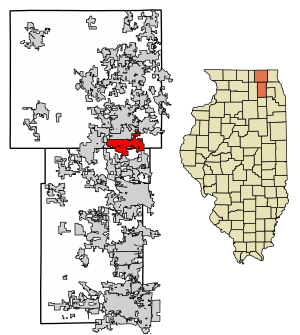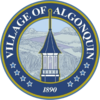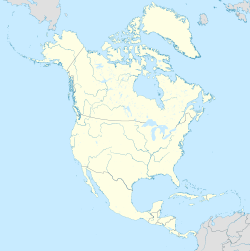Algonquin, Illinois facts for kids
Quick facts for kids
Algonquin, Illinois
|
|||
|---|---|---|---|
|
Village
|
|||
|
|||

Location of Algonquin in Kane and McHenry Counties, Illinois
|
|||
| Country | United States |
||
| State | Illinois | ||
| Counties | McHenry, Kane | ||
| Townships | Algonquin, Grafton, Dundee, Rutland | ||
| Incorporated | 1890 | ||
| Government | |||
| • Type | Council–manager | ||
| Area | |||
| • Total | 12.34 sq mi (31.96 km2) | ||
| • Land | 12.14 sq mi (31.43 km2) | ||
| • Water | 0.20 sq mi (0.52 km2) | ||
| Population
(2020)
|
|||
| • Total | 29,700 | ||
| • Density | 2,447.06/sq mi (944.82/km2) | ||
| ZIP code(s) |
60102
|
||
| Area code(s) | 847 & 224 | ||
| Geocode | 00685 | ||
| FIPS code | 17-00685 | ||
Algonquin is a village in Illinois, located in both McHenry and Kane counties. It's a suburb of Chicago, about 40 miles (64 km) northwest of the city center. In 2020, about 29,700 people lived here. Algonquin is often called "The Gem of the Fox River Valley" because of its beautiful downtown area.
Contents
- Where is Algonquin Located?
- How Many People Live in Algonquin?
- Algonquin's History: From Native Americans to a Modern Village
- Education in Algonquin
- Businesses and Industry in Algonquin
- Shopping in Algonquin
- Fun Things to Do in Algonquin
- Festivals and Traditions in Algonquin
- Getting Around Algonquin: Transportation
- Places of Worship in Algonquin
- Famous People from Algonquin
- See also
Where is Algonquin Located?
Algonquin is in southeastern McHenry County and northeastern Kane County. It shares borders with Lake in the Hills to the north and Carpentersville to the south. The village covers about 12.41 square miles (32.14 km²). Most of this area (about 98.55%) is land, with a small part being water. About 78% of Algonquin is in McHenry County, and the rest is in Kane County.
How Many People Live in Algonquin?
| Historical population | |||
|---|---|---|---|
| Census | Pop. | %± | |
| 1880 | 286 | — | |
| 1900 | 550 | — | |
| 1910 | 642 | 16.7% | |
| 1920 | 693 | 7.9% | |
| 1930 | 850 | 22.7% | |
| 1940 | 926 | 8.9% | |
| 1950 | 1,223 | 32.1% | |
| 1960 | 2,014 | 64.7% | |
| 1970 | 3,515 | 74.5% | |
| 1980 | 5,684 | 61.7% | |
| 1990 | 11,663 | 105.2% | |
| 2000 | 23,276 | 99.6% | |
| 2010 | 30,046 | 29.1% | |
| 2020 | 29,700 | −1.2% | |
| U.S. Decennial Census 2010 2020 |
|||
Algonquin's Population in 2020
In 2020, Algonquin had a population of 29,700 people. The village is home to a diverse group of residents.
| Race / Ethnicity (NH = Non-Hispanic) | Pop 2000 | Pop 2010 | Pop 2020 | % 2000 | % 2010 | % 2020 |
|---|---|---|---|---|---|---|
| White alone (NH) | 21,327 | 24,847 | 22,327 | 91.63% | 82.70% | 75.18% |
| Black or African American alone (NH) | 194 | 507 | 704 | 0.83% | 1.69% | 2.37% |
| Native American or Alaska Native alone (NH) | 20 | 43 | 27 | 0.09% | 0.14% | 0.09% |
| Asian alone (NH) | 542 | 2,174 | 2,143 | 2.33% | 7.24% | 7.22% |
| Pacific Islander alone (NH) | 2 | 11 | 7 | 0.01% | 0.04% | 0.02% |
| Other race alone (NH) | 41 | 31 | 85 | 0.18% | 0.10% | 0.29% |
| Mixed race or Multiracial (NH) | 202 | 388 | 1,048 | 0.87% | 1.29% | 3.53% |
| Hispanic or Latino (any race) | 948 | 2,045 | 3,359 | 4.07% | 6.81% | 11.31% |
| Total | 23,276 | 30,046 | 29,700 | 100.00% | 100.00% | 100.00% |
Algonquin's Population in 2010
In 2010, Algonquin had 30,046 people living in 10,247 households. About 44.6% of these households had children under 18. The average household size was 2.93 people. The median age in the village was 38.3 years.
Algonquin's History: From Native Americans to a Modern Village
Long ago, before Europeans arrived, the Potawatomi Native Americans lived in the Algonquin area. There were even ancient burial mounds here.
The first European settler, Samuel Gillilan, came from Virginia in 1834. Other settlers soon followed. There was some debate about the village's name, with ideas like Denny's Ferry and Osceola. But on December 23, 1847, the name Algonquin became official, thanks to Samuel Edwards.
Early Growth and the Railroad
A big step for Algonquin's economy happened in 1855. A railroad was built, which made it easier for local farmers to send their products to markets in Chicago. This helped the area grow. Finally, on February 25, 1890, the Village of Algonquin was officially formed.
Village Hall and the Algonquin Hill Climbs
The first Village Hall was built on January 31, 1907, at 2 South Main Street. It's still there today, serving as a historical landmark and a community spot. A new village hall was built in 1996.
From 1906 to 1913, Algonquin became famous for its "Hill Climbs." This was an event where car companies tested their automobiles by driving them up steep hills in the village. If a car made it, it got a "stamp of approval." The "Algonquin Cup" was created for this event and became nationally recognized. Today, a festival still celebrates this historic race.
Algonquin as a Resort Town and Modern Development
For much of the 1900s, Algonquin was a popular resort town. People from Chicago would visit to enjoy the Fox River and escape city life. Many summer homes were built, and soon, more people started living in Algonquin year-round.
The village remained small until the 1980s, when its population grew rapidly with new homes. This growth continued through the 1990s and 2000s. The first shopping center, Algonquin Town Center, opened in the late 1980s. In the 1990s, development shifted to Randall Road, bringing many new stores and restaurants.
In 2004, the Algonquin Commons outdoor mall opened. It's one of the largest outdoor malls in Illinois. The Algonquin Galleria followed, with its first stores opening in 2006. The Algonquin Corporate Campus also began development, aiming to bring many new jobs to the area.
Education in Algonquin
Algonquin is served by two main school districts and also has private school options.
Community Unit School District 300
This is a large school district that serves many students in Algonquin, especially those living near and east of Randall Road.
- Elementary Schools (K-5): Neubert, Lincoln Prairie, Eastview, Algonquin Lakes, Lake in the Hills, and Liberty Elementary Schools.
- Middle Schools (6-8): Westfield Community School (which also has an elementary section), Dundee Middle School, and Algonquin Middle School.
- High Schools (9-12): Harry D. Jacobs High School and Dundee-Crown High School.
Consolidated School District 158
This district is based in Algonquin and serves the western parts of the village, as well as nearby communities like Huntley.
- Elementary Schools: Mackeben Elementary School (K-2) and Marion Conley Elementary School (3-5).
- Middle School: Bernice Heinemann Middle School (6-8).
- High School: Huntley High School (9-12).
Private Schools
Algonquin has private school options for students:
- St. Margaret Mary Catholic School offers K-8 education.
- Foundations Montessori School is on the west side of town.
Community Colleges
For higher education, the closest community colleges are McHenry County College and Elgin Community College.
Libraries
Most of Algonquin is served by the Algonquin area public library district, which has two locations. Other libraries like Huntley Public Library also serve parts of the village.
Businesses and Industry in Algonquin
Algonquin has a growing number of businesses, from manufacturing to corporate offices.
Algonquin Industrial Park
This park is located west of the Old Town District. It's home to companies that make tools, dies, and plastic products. The main Post Office for Algonquin and nearby Lake in the Hills is also here.
Algonquin Corporate Campus
This large development on the west side of Algonquin aims to create many jobs. It covers over 1,000 acres (400 ha) and is designed to attract businesses in healthcare, technology, and research. The Algonquin Commons and Algonquin Galleria malls are right next to this campus.
Other Businesses
Other important businesses include Duro-Life, which makes machine parts, and Meyer Material Service, a mining company. There are also many smaller offices and medical spaces throughout the village, especially along Randall Road.
Shopping in Algonquin
Algonquin is a popular place for shopping and dining, both for local residents and people from the surrounding region.
Randall Road Corridor
This area is a major shopping, dining, and entertainment hub. It has many large outdoor malls and big stores. It serves most of McHenry and northern Kane Counties.
East Algonquin Road Corridor
This area is more for local shopping, serving eastern Algonquin and nearby areas. It includes Algonquin's first shopping center, Algonquin Town Center.
West Algonquin Road Corridor
This newer shopping area has smaller shops, restaurants, and local services. It mainly serves western Algonquin and Lake in the Hills.
Old Town District
Algonquin's Old Town District, along Main Street/Illinois Route 31, features many unique local shops, restaurants, and offices.
Fun Things to Do in Algonquin
Algonquin has many parks, trails, and programs for recreation. The beautiful Fox River is also a big draw.
- Downtown Algonquin: A lively area with shops and restaurants near the Fox River.
- The Fox River: A major river that flows through the heart of downtown, offering many fun activities.
- Fox River Trail/McHenry County Prairie Path: Part of the larger Grand Illinois Trail, great for walking and biking.
- Trail System: Over 26 miles (42 km) of trails for walking and biking.
- Parks:
* Kelliher Park: Has several ballfields. * Ted Spella Park: A large park still being developed. * Snapper Field and Lions Pool: A complex with ballfields and a public swimming pool. * Towne Park, Cornish Park, and Riverfront Park: Downtown parks used for festivals like Founders Days. * Presidential Park: An important park for eastside residents with ballfields and picnic areas. * Hill Climb Park: A newer park at Circle and Huntington Drives.
- Lakes and Nature:
* Algonquin Lakes: A group of natural and man-made lakes with trails. * Manchester Lakes: Man-made lakes with a bike path system. * Woods Creek: A scenic creek, nature preserve, and trail on the western side of the village.
- Sports Organizations:
* ALITHSA (Algonquin Lake in the Hills Soccer Association): Offers soccer for kids of all ages. * AAYO (Algonquin Area Youth Organization): Organizes tee-ball, softball, and baseball leagues.
- Golf Course of Illinois: A popular golf course located near Randall Road.
Festivals and Traditions in Algonquin
Algonquin hosts many exciting events throughout the year.
- The Hill Climb Race: A historic event where classic cars drive up a steep hill in downtown Algonquin. It's held in the spring.
- Algonquin Summer Concerts: Free outdoor music performances at Towne Park on Thursdays during the summer.
- Art on the Fox: A fine art festival on Main Street, usually in September, featuring artwork, live music, and artist demonstrations.
- Founders' Days: The village's biggest festival, held on the last full weekend of July. It includes a carnival, parade, fireworks, and more.
- National Night Out: An event in early August at Snapper Field to promote community safety.
- Algonquin Commons Events: The mall hosts events like Touch-a-Truck and holiday carriage rides.
- Algonquin's Public Art Program: Showcases different artworks in public places throughout the year.
- Polish-American Fest: Held at Saint Margaret Mary's Catholic Church, celebrating the large Polish community in Algonquin.
- Miracle On Main: A holiday festival on Main Street, usually the first Saturday of December, with ice sculptures and live performances.
Getting Around Algonquin: Transportation
Algonquin is a key transportation hub for McHenry and Kane Counties.
Major Roads
- Randall Road: A large highway on the western side of the village, lined with shopping centers and businesses. It connects Algonquin to Crystal Lake, Elgin, and other Fox River Valley suburbs.
- Illinois Route 25: A north-south road on the eastern side, connecting to Carpentersville and other towns to the south.
- Illinois Route 31 (Main Street): A main north-south road through downtown. It can get busy, and a bypass is planned to help with traffic. It connects to Crystal Lake and McHenry to the north, and Elgin and St. Charles to the south.
- Illinois Route 62 (Algonquin Road): A major east-west road. It connects Algonquin to Huntley on the west and other Chicago suburbs like Schaumburg and Arlington Heights to the east.
- Lake Cook Road: Connects Algonquin to Barrington, Palatine, and other suburbs to the east.
- Longmeadow Parkway: An east-west road that will connect Randall Road to Illinois Route 62, including a new bridge over the Fox River.
Bus Service
Pace provides bus service on Route 550 along Randall Road, connecting Algonquin to Crystal Lake and Elgin.
Places of Worship in Algonquin
Algonquin has several churches serving its community:
- St. Margaret Mary Catholic Church: A large church complex with a school. It offers services, including Polish-speaking masses, for the Polish community.
- St. John's Evangelical Lutheran Church: Located in the Old Town District, it also has a K-8 school.
- Congregational Church of Algonquin: Found in the Old Town District.
- Light of Christ Lutheran Church: Located at Sleepy Hollow Road and Longmeadow Parkway.
- Christ United Methodist Church: Just outside the village limits on West Algonquin Road.
Famous People from Algonquin
Algonquin has been home to several notable individuals:
- Rockne Brubaker: An ice skater and two-time national champion.
- Josh Caterer: A musician.
- Evan Jager: An American record-holder in the 3,000-meter steeplechase and a silver medalist at the 2016 Summer Olympics.
- Cameron Krutwig: A professional basketball player in Spain.
See also
 In Spanish: Algonquin (Illinois) para niños
In Spanish: Algonquin (Illinois) para niños






